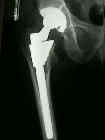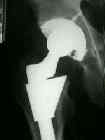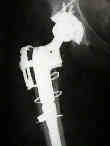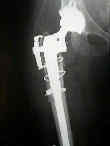- See:
- Removal of Cemented Femoral Stems:
- Removal of Press Fit Stems:
- Discussion:
- stem considerations:
- calcar replacment: bone loss at the lower limit of the lesser trochanter may requires a 30-mm calcar replacement;
- length: stems that are longer than 175 mm long will require an anterior bow to accomodate the femoral anatomy;
- proximal femoral fixtion:
- for bone ingrowth to occur, there needs to be close contact between the porous surface and host bone;
- if there is poor proximal bone stock ingrowth is less likely to occur which may result in subsidence and loosening of the stem;
- if metaphyseal bone is expanded or thin consider diaphsyeal fixation;
- alternatively, the surgeon may choose a proximal fixation stem, with the plan of adding cancellous allograft chips, which will
restore close contact of bone to the component surface and which may allow reconstitution of the proximal femur;
- if bone is deficient in the proximal femur then consider calcar replacing prosthesis w/ diaphyseal fixation;
- for ingrowth to occur adequate stability must also be present, which often requires insertion of a long stem prosthesis;
- femoral diaphyseal fixation:
- revision femoral stem length should be 1-3 cm longer than original stem;
- stratedgy involves bypassing the deficient proximal bone inorder to achieve more secure distal fixation;
- requires at least 5 cm of tight diaphyseal fixation;
- if there is femroal cortical disruption, the revision stem should extend two to three shaft diameters distal to the defect;
- requires an implant which has adequate porous coating and adequate thickness to achieve satisfactory fit;
- Bone Grafting for Femoral Defects:
- allografts can be morcellized and when mixed w/ cancellous autograft can effectively graft large contained defects;
- Specific Components:
- SROM components:
- Biomet - Mallory Head Prosthesis:
- Cerclage Fixation Techniques: (from Cheng, et al (1993))
- Hairpin Cerclage Knot
- is significantly stronger than other fixation techniques;
- technique:
- wire is bent into a "U" shape;
- "U" is then passed around one end of the bone;
- one of the free ends of the wire is passed thru the "U" of the loop, and then the free ends of the wire are tension w/ a single throw
of a square knot;
- Harris Wire Tightener:
- single throw of a square knot is thrown and is then tensioned w/ the Harris wire tightener;
- wire is twisted 180 deg while under tension (more twisting may break wire);
- Harris tightener is released and final twisting is completed with pliers
- references:
- A comparison of the strength and stability of six techniques of cerclage wire fixation for fractures.
Outcome of revision hip arthroplasty done without cement.
The rationale of cementless revision of cemented arthroplasty failures.
Preparation of the proximal femur in cementless total hip revision.
Results of cementless revisions of total hip arthroplasties using the Harris-Galante prosthesis.
Results of cementless revision for failed cemented total hip arthroplasty.
Cementless revisions of failed aseptic cemented and cementless total hip arthroplasties. 284 cases.
Revision of failed total hip arthroplasties with uncemented porous-coated anatomic components.
Preparation of the proximal femur in cementless total hip revision.
Rationale, experience, and results of long-stem femoral prosthesis.





